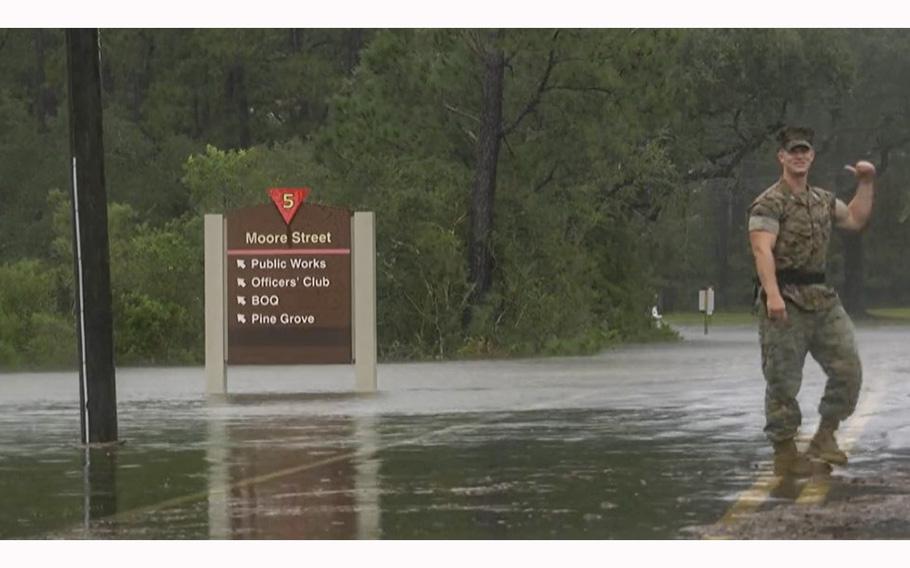
A video screen grab shows a Marine standing on a road overflow with rainwater from Hurricane Irma at Marine Corps Air Station Beaufort, S.C., on Sept. 11, 2017. (U.S. Marine Corps)
HILTON HEAD ISLAND, S.C. (Tribune News Service) — Decades ago, developing the Marine Air Corps Station Beaufort was about modifying the Lowcountry land to fit the military's needs.
But more recently, as more storms and rising seas threaten parts of the low-lying air base, it's time to work alongside Mother Nature, said Gary Herndon, the air station's natural and cultural resources manager.
"Were here for a reason — to train pilots," Herndon said. "The only way we can do that is being responsible stewards of the land."
Scientists say the base's 6,900 acres could be partially swallowed by flooding and sea level rise if left unchecked.
The National Oceanic and Atmospheric Administration selected The Nature Conservancy for a grant that will fund $6.2 million in South Carolina coastal resilience and habitat restoration projects. A chunk of that money will help the air base address erosion that's happening near a housing area.
The money will be used to build oyster-castle living shorelines consist of interlocking concrete blocks that become living reefs as oyster larvae attach to them and grow all while helping reduce wave energy and erosion along the shoreline. Building and placing living shorelines keep the water clean, build up salt marshes, create wildlife habitats and support important local resources, such as the commercial fishing industry.
If predictions by the Union of Concerned Scientists hold, current flood-prone areas at MCAS Beaufort could experience tidal flooding more than 300 times a year by 2050, given the highest scenario. And in an end-of-century, worst-case scenario, a Category 4 hurricane storm would bring 6 feet of sea level rise and maybe double the area exposed to flood depths of 20 feet or more.
On top of flooding and sea level rise, heavy boating activity, wind-driven waves and high tidal energy eat away at the shorelines.
Already, parts of the air base's shorelines have eroded. About 10 years ago, base leaders turned to living shorelines to solve erosion issues near the airfield.
Joy Brown, the organization's marine program manager, said constructing a half-mile living shoreline at Laurel Bay on the Broad River is the first task in The Nature Conservancy's four-year process to scale up the use of nature-based solutions for South Carolina's coastal resilience.
When Brown saw the erosion at Laurel Bay, which threatened the base's housing area, she told Herndon it was the "perfect" place for a living shoreline.
"The stars aligned," Herndon said.
The main concern isn't housing washing into the water. Rather, the issues are the waning shoreline and the loss of marsh and trees.
"Years down the road, yes, if left, it would've threatened structures of houses," he said.
Herndon said a living shoreline in the area is a long-term solution, but it isn't a quick-fix. It'll take time to build back the marsh in order to slow wave action that's eroded the shoreline.
MCAS Beaufort isn't the only base embracing natural solutions to Mother Nature's threat. In December, the National Fish and Wildlife Foundation awarded nearly $1.2 million from its National Coastal Resilience Fund to Parris Island Marine Corps Recruit Depot and partner organizations to install living shorelines near the base.
"The DoD (Department of Defense) in the last couple years has really started to focus in on resilience and adaptation efforts for their bases," Brown said. "We had that top-down messaging coming through to them of thinking about 'How are you going to have a sustainable base into the future?'"
Brown said The Nature Conservancy has already submitted permits to place the living shoreline at Laurel Bay. She predicted it'll take about eight volunteer events to get the project built.
The MCAS Beaufort living shoreline is a smaller chunk of the $6 million-plus grant that will build living shorelines and do coastal nature-based resilience projects.
The grant will also establish a community assistance program, which will partner with the Gullah Geechee Cultural Heritage Corridor, to help under-served communities build living shorelines. Brown said the third task is developing an implementation plan for coastal development that'll last 10 years and establish more large-scale, nature-based solutions to protect South Carolina's coast.
"All of these paths are trying to set us up for the future," Brown said. "We're not going to go out tomorrow and install a 10-acre living shoreline, but I feel like we're setting up South Carolina to really start getting to that scale."
(c)2023 The Island Packet (Hilton Head, S.C.)
Visit The Island Packet
Distributed by Tribune Content Agency, LLC.